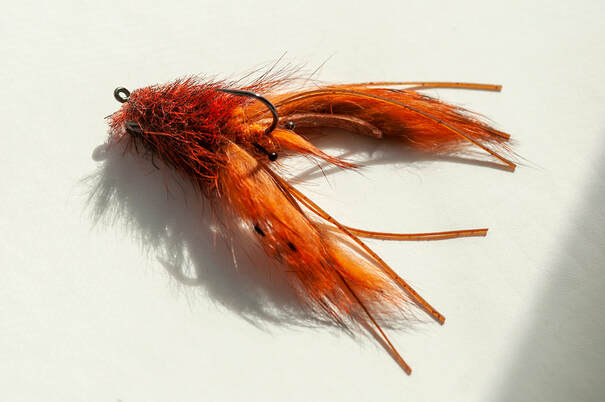Fly of the Month 02.22
One of the first things we learn about the habits of trout is the fact that they feed on the bottom for a majority of their foraging time. However, dry fly fishing is so much fun, we anglers often ignore this fact and of course likely catch fewer fish. Those anglers that leverage this knowledge fly fish more often with nymphs and streamers. We associate streamer fly fishing with the imitation of forage fish. The fish eat fish approach.
However, our Southern Appalachian streams provide a most fundamental, year-round forage food for trout and it is not just another fish, it is the crayfish!. A freshwater crustacean also known as craydid, crawfish, crawdaddy, crawdad, freshwater lobster, mountain lobster, rock lobster, mudbug or yabby (a name from the land down under).
Crayfish
The Woolly Bugger is probably the most primitive imitation of a crayfish. But its effectiveness is due to its resemblance to so many edible creatures in the water. For both coldwater and warmwater streams, a more realistic crayfish fly pattern is more often used.
Fly patterns for a crayfish may be tied with the classic approach with the tail extending from the top of the bend of the hook. However these crayfish fly patterns are like the woolly bugger and when weighted tend to catch on objects on the bottom due to the down hook and forward strip. The most productive crayfish fly patterns are tied hook up like a clouser but in reverse with the tail at the hook eye. As the fly pattern is stripped, the natural backward retreating motion of the crayfish is exactly imitated.
Crayfish tend to be a dark earth tone color that blends well with the surrounding bottom. Amber, brown and olive are the most typical colors of crayfish fly patterns. Smaller hook sizes 2-8 are typically tied for trout and smallmouth bass and sizes 1/0-4 are typically tied for largemouth bass. Underbody non-toxic lead substitute wraps is the best means of adding weight to keep the fly pattern near the bottom. The focus on suggestive or realistic claws, antennae, beady eyes and tail flap tend to make more productive crayfish fly patterns.
To fish the Crayfish as a streamer, cast across and downstream and allow the fly to tail-out, then strip the fly back upstream. Often then the trout will take the fly on the tail-out or soon after the strip begins. This technique is highly effective working across the riffle area between pools and just beyond the riffles.
Any large, deep pool may be fished with a Crayfish by casting across the pool, allowing the fly to sink to near bottom. Strip back across the bottom much like one would retrieve a spinner in the trout’s territory.
To fish the Crayfish as a wet fly, cast across and upstream and allow the fly to dead drift near the bottom downstream while controlling the slack. Allow the fly to parallel the bottom a much as possible and at the end of the drift. This technique is most effective in the deeper runs.
The Crayfish is a must have fly pattern in smallmouth streams and in the deeper pools of trout streams.
Little Piney Crawfish (trout)
Crusty Craw Crayfish (smallmouth)
Crawdad Craig (largemouth bass)
Fly of the Month 02.22
- Tom Adams, Alen Baker
One of the first things we learn about the habits of trout is the fact that they feed on the bottom for a majority of their foraging time. However, dry fly fishing is so much fun, we anglers often ignore this fact and of course likely catch fewer fish. Those anglers that leverage this knowledge fly fish more often with nymphs and streamers. We associate streamer fly fishing with the imitation of forage fish. The fish eat fish approach.
However, our Southern Appalachian streams provide a most fundamental, year-round forage food for trout and it is not just another fish, it is the crayfish!. A freshwater crustacean also known as craydid, crawfish, crawdaddy, crawdad, freshwater lobster, mountain lobster, rock lobster, mudbug or yabby (a name from the land down under).
Crayfish
The Woolly Bugger is probably the most primitive imitation of a crayfish. But its effectiveness is due to its resemblance to so many edible creatures in the water. For both coldwater and warmwater streams, a more realistic crayfish fly pattern is more often used.
Fly patterns for a crayfish may be tied with the classic approach with the tail extending from the top of the bend of the hook. However these crayfish fly patterns are like the woolly bugger and when weighted tend to catch on objects on the bottom due to the down hook and forward strip. The most productive crayfish fly patterns are tied hook up like a clouser but in reverse with the tail at the hook eye. As the fly pattern is stripped, the natural backward retreating motion of the crayfish is exactly imitated.
Crayfish tend to be a dark earth tone color that blends well with the surrounding bottom. Amber, brown and olive are the most typical colors of crayfish fly patterns. Smaller hook sizes 2-8 are typically tied for trout and smallmouth bass and sizes 1/0-4 are typically tied for largemouth bass. Underbody non-toxic lead substitute wraps is the best means of adding weight to keep the fly pattern near the bottom. The focus on suggestive or realistic claws, antennae, beady eyes and tail flap tend to make more productive crayfish fly patterns.
To fish the Crayfish as a streamer, cast across and downstream and allow the fly to tail-out, then strip the fly back upstream. Often then the trout will take the fly on the tail-out or soon after the strip begins. This technique is highly effective working across the riffle area between pools and just beyond the riffles.
Any large, deep pool may be fished with a Crayfish by casting across the pool, allowing the fly to sink to near bottom. Strip back across the bottom much like one would retrieve a spinner in the trout’s territory.
To fish the Crayfish as a wet fly, cast across and upstream and allow the fly to dead drift near the bottom downstream while controlling the slack. Allow the fly to parallel the bottom a much as possible and at the end of the drift. This technique is most effective in the deeper runs.
The Crayfish is a must have fly pattern in smallmouth streams and in the deeper pools of trout streams.
Little Piney Crawfish (trout)
Crusty Craw Crayfish (smallmouth)
Crawdad Craig (largemouth bass)
Fly of the Month 02.22
- Tom Adams, Alen Baker
Name: Crusty Craw
Recipe :
Hook : Ahrex TP size 1/0
Thread : UTC 70 White
Dub : Burnt Orange Hare’s Ear blend with Burnt Orange Ice dub 50/50 blend
Body : Puglisi Chromatic Brush 1.5 inch in Tiger
Eyes : Stonflo Plastic V eyes
Legs : Crazy Legs Brown/Orange Flake
Claws : Micro Rabbit strips in Crawfish Orange
Lead dumb bell eye in black
Directions :
Recipe :
Hook : Ahrex TP size 1/0
Thread : UTC 70 White
Dub : Burnt Orange Hare’s Ear blend with Burnt Orange Ice dub 50/50 blend
Body : Puglisi Chromatic Brush 1.5 inch in Tiger
Eyes : Stonflo Plastic V eyes
Legs : Crazy Legs Brown/Orange Flake
Claws : Micro Rabbit strips in Crawfish Orange
Lead dumb bell eye in black
Directions :
- Debarb and mount the hook. Begin at the top of the downturn of the hook shank just above the eye with thread wraps to just where the shank becomes straight. Select a lead dumb bell and secure at just where the shank starts to bend down with multiple “x” wraps. Advance the thread to the hook bend. Add glue to secure the dub bell.
- Select a small portion of Micro Rabbit and cut or strip away from the hide. Tie this clump in about half past the bend. Tie in on top of the shank and take thread wraps up the bend to secure and smooth the tie in.
- Form a small ball of thread at the tie in point of the rabbit just tied in.
- Select a Stonflo eye and secure on top of the hook shank immediately behind the thread ball. The thread will aid in making the eyes stand out from the body. The eyes should be parallel with the shank.
- Dub the thread and form another ball on top of the thread covering the eye tie in. The eyes have a length of plastic used to hold the eyes in place. Cover this with the dubbing.
- Select three Crazy Legs and tie in at their center point immediately behind the dubbing ball on top of the hook shank. As you bind them in make them secure on each side of the hook shank. It will make three on each side.
- Make another dubbing ball, larger than the first and cover the first ball while trapping the legs as well.
- Select a length of Micro Rabbit strip and measure the length to go from behind the dubbing ball with enough length to tie in to about a hook gap plus past the bend of the hook. The legs should not be but fractionally longer than the Crazy legs (which have not been trimmed as of yet).
- Duplicate the length with another from the hide.
- Orient the rabbit such that the natural taper is toward the hook bend. Then slightly trim the hide from the outward tip to imitate the tip of the claw. Strip a quarter inch or so of fur leaving some bare skin to tie in by and tie the rabbit claw in on the side of the hook shank immediately behind the dubbing ball. Repeat with the other strip.
- Cover the rabbit hide with several wraps of thread and form a very small taper heading to the eye. It is not necessary to wrap to the eye.
- Select a dubbing brush and tie in on top of the hook shank immediately behind the dubbing ball and leave the thread at the dumb bell.
- Wrap the dubbing brush to the eye in tight touching turns stroking back the fibers to avoid bunching. The wraps of dubbing brush will continue past the dumb bell with two or three wraps in to the eye. Secure with several tight thread wraps and trim the waste. Make a small head of thread and several whip finishes and cut the thread.
- Stroke back the brush with a toothbrush and trim any “crazy” fibers. Turn the hook “upside” down and trim the brush away from the hook point.

